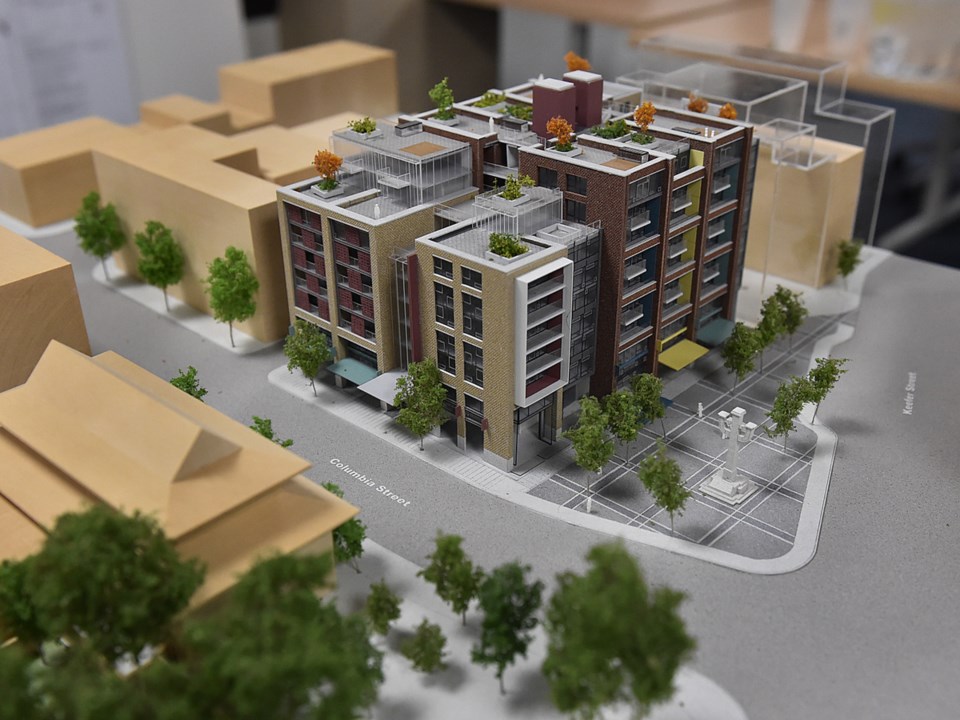A development company whose condo proposal for Chinatown was rejected by city council in June was rejected again Monday by the city's development permit board in a 2-1 vote.
Beedie Development Group had revised its 12-storey proposal for its property at 105 Keefer St. to nine storeys in an attempt to get approval from the development permit board.
But board members Jerry Dobrovolny, who is the city's chief engineer, and Gil Kelley, the city's director of planning, rejected the application for reasons based primarily on design.
Paul Mochrie, the city's deputy city manager, supported the project, saying the application met the requirements of existing zoning regulations.
In providing reasons for their decisions, Dobrovolny and Kelley also referred to the widespread opposition to Beedie's project from hundreds of people who spoke at the public hearings in May and June, and more than 100 who spoke last week to the board.
"We heard from a very engaged, passionate public," said Dobrovolny as more than 150 people at city hall listened to him speak. "There were some different views about what the right thing to do was. But clearly all of the speakers cared a great deal about Chinatown, cared about its heritage, they cared about its cultural significance."
Dobrovolny said the revised version of the project's exterior surface didn't fully satisfy design guidelines and he believed the massing of the building should be reduced.
He recommended Beedie hire a professional artist "with local contextual knowledge for the detailed development of the building's ornamentation, decorative panels, fittings, railings and brick work."
Houtan Rafii, vice-president of residential development for Beedie, declined to comment on the board's decision as he left the room to speak to the city's assistant director of urban design, Anita Molaro. The development company has revised its proposal at least five times.
The developer got a second chance this year to get approval for the project because it reduced the height of its original 12-storey proposal at 118 feet to 90 feet, which is allowed under the city’s current policies and doesn’t require a rezoning or public hearing.
The original proposal included 25 apartments of social housing for seniors, although only three would be available at welfare rates. Beedie only promised the 25 units after negotiating a deal with B.C. Housing to pay for it. That deal did not apply to the revised proposal, which called for 111 market condo units.

Kelley agreed with Dobrovolny that the project didn't meet the "design test" and needed significant improvement. He described the property as "an important site of such design significance to Chinatown."
"I really do appreciate the effort everybody has put into this, and I hope there's a constructive pathway forward," he said, noting he recommended the city get involved to help facilitate a better dialogue between the developer and the community.
In the foyer outside the meeting room, members of the Chinatown Action Group and Chinatown Concern Group, comprised of dozens of young people and seniors, celebrated the board's decision.
"Today, the board made a bold choice," said Vincent Tao of the Chinatown Action Group. "I guess we're happy with the decision, but we're waiting for Beedie to appeal. But I think Beedie is running scared and we're ready for the next round of the fight."
Other members of the groups, Nathanel Lowe and Jannie Leung, said they didn't expect the majority of the board to reject Beedie's proposal. He based that on the board and some councillors suggesting their groups were being disrespectful to those in favour of the project.
"In the end, the people power won," said Lowe, noting residents want social housing to be built on the property, which is in front of the Chinatown Memorial Plaza and across the street from Dr. Sun Yat-Sen Garden.
The city announced last week that negotiations to buy the property from Beedie, or negotiate a land swap, failed. B.C. Housing, the provincial government's housing arm, was involved in the negotiations. The city said in May the property was worth at least $22 million.
Leung said members of the groups will continue to lobby governments for ways to get social housing on the property, with increased pressure on the federal government.
Former city planner Nathan Edelson, whose responsibility included Chinatown, was in the room when the board rejected Beedie's proposal.
Edelson said he believed city council's to deliver an official apology next April to Chinese people for decades of legislated discrimination by previous city councils factored in the board's decision.
"We have to find ways of having a better process that everybody can participate in, and also to get a building in a key part of Chinatown that really reflects the culture of the community," he said, referring to the need for immediate translation services for Chinese people, particularly seniors who want their views heard at city hall. "This [decision] was an opportunity to make sure that we can start on the road to really engage the Chinese community in a good way to the future."
When council by a vote of 8-3, Mayor Gregor Robertson and seven councillors raised various concerns, saying the building’s design was too bulky and would block views and cast shadows on neighbouring Dr. Sun Yat-Sen Garden.
Also, the building wouldn’t preserve the heritage and cultural character of Chinatown, and there wasn’t enough social housing in the plan, they said.
Along with reducing the height of the building, Beedie’s revised proposal set back the eighth and ninth floors of the design so that it appeared less bulky and didn’t cast shadows on the Garden.
A community cultural space remained from the original design, as did narrow retail shops at ground level to keep with Chinatown’s character of shops and restaurants. The pedestrian space around the Chinatown Memorial Plaza was to increase by 26 per cent.
The building was to include a large vertical neon sign and a pedestrian passageway from the main entrance of the building to a refurbished lane, which the proposal’s documents said “the intent is to animate the lane and stimulate positive social activity and events.”
The property was once home to a gas station and is now a parking lot.
@Howellings



